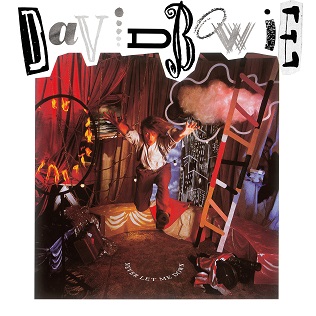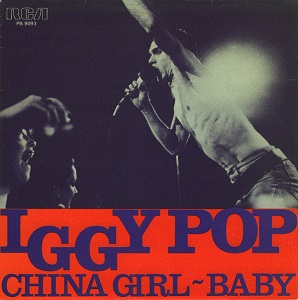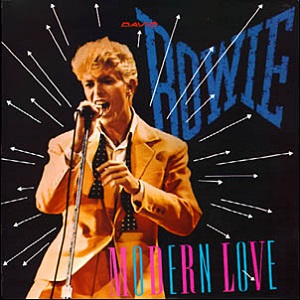
During his lifetime, English singer-songwriter David Bowie (1947–2016) released 26 studio albums, 9 live albums, 2 soundtrack albums, 26 compilation albums, 8 extended plays, 128 singles and 6 box sets. Since his death, 1 further studio album, 13 live albums, 1 soundtrack album, 1 compilation album, 4 extended plays and 6 box sets have been released. Bowie also released 28 video albums and 72 music videos. Throughout his lifetime, Bowie sold roughly 140 million records worldwide. In 2012, Bowie was ranked ninth best selling singles artist in United Kingdom with 10.6 million singles sold. As of January 2016, 12.09 million Bowie singles had been sold in Britain. In a period of 24 months since his death, 5 million records were sold in UK, 3.1 million singles and 2 million albums.

Let's Dance is the 15th studio album by the English singer-songwriter David Bowie, released on 14 April 1983 through EMI America Records. After the release of Scary Monsters (1980), Bowie began a period of numerous musical collaborations and film appearances. By 1982, he left RCA Records out of dissatisfaction and signed with EMI America. Wanting a fresh start, he chose Nile Rodgers of the band Chic to co-produce his next record.

"Blue Jean" is a song written and recorded by the English singer-songwriter David Bowie for his sixteenth studio album Tonight (1984). One of only two tracks on the album to be written entirely by Bowie, it was released as a single ahead of the album and charted in the United States, peaking at No. 8, becoming his 5th and last top 10 hit with no features. The song is loosely inspired by Eddie Cochran.

Tonight is the 16th studio album by the English singer-songwriter David Bowie, released on 24 September 1984 through EMI America Records. The follow-up to his most commercially successful album Let's Dance, it was written and recorded in mid-1984 at Le Studio in Morin-Heights, Canada, following the conclusion of the Serious Moonlight Tour. Bowie, Derek Bramble and Hugh Padgham co-produced the album. Many of the same personnel from Let's Dance and the accompanying tour returned for Tonight, with a few additions. Much of Bowie's creative process was the same as he used on Let's Dance, similarly playing no instruments and offering little creative input to the musicians.

Never Let Me Down is the 17th studio album by the English musician David Bowie, released on 21 April 1987 through EMI America Records. Co-produced by Bowie and David Richards and featuring guitarist Peter Frampton, the album was recorded in Switzerland and New York City from September to November 1986. Bowie's goal for the project was to record it differently following his disappointment with 1984's Tonight. Musically, Never Let Me Down has been characterised as pop rock, art rock and hard rock; Bowie himself considered the record a return to rock and roll music. The cover artwork features Bowie surrounded by numerous elements from the songs.

Black Tie White Noise is the 18th studio album by the English musician David Bowie, released on 5 April 1993 through Savage Records in the United States and Arista Records in the United Kingdom. Conceived following the disbandment of Bowie's rock band Tin Machine and his marriage to model Iman, it was recorded throughout 1992 between studios in Montreux, Los Angeles and New York City. Bowie co-produced with his Let's Dance (1983) collaborator Nile Rodgers, who voiced dissatisfaction with the project in later decades. The album features several guest appearances, including previous collaborators Mike Garson and Mick Ronson, and new arrivals Lester Bowie and Chico O'Farrill.

Tin Machine is the debut studio album by the Anglo-American hard rock band Tin Machine, released on 22 May 1989 through EMI America Records. The band consisted of the English singer-songwriter David Bowie, the American guitarist Reeves Gabrels and brothers Tony Fox and Hunt Sales on bass and drums, respectively, while Englishman Kevin Armstrong acted as an additional guitarist. The project was spearheaded by Bowie, who felt disconnected in his career by 1987 and looked to reinvent himself. After meeting Gabrels through his Glass Spider Tour, the two agreed to work together and would collaborate frequently for the next decade. Bowie hired the Sales brothers, neither of whom he had worked with since the 1970s, after a meeting in Los Angeles, while English producer Tim Palmer was hired to co-produce.

"Fame" is a song recorded by the English singer-songwriter David Bowie. It was released on his 1975 album Young Americans and was later issued as the album's second single by RCA Records in June 1975. Written by Bowie, Carlos Alomar and John Lennon, it was recorded at Electric Lady Studios in New York City in January 1975. It is a funk rock song that represents Bowie's dissatisfaction with the troubles of fame and stardom.

"Cat People (Putting Out Fire)" is a song recorded by the English singer-songwriter David Bowie as the title track of the 1982 erotic horror film Cat People. Bowie became involved with the track after director Paul Schrader reached out to him about collaborating. The song was recorded at Mountain Studios in Montreux, Switzerland in July 1981. Bowie wrote the lyrics, which reflected the film, while the Italian producer Giorgio Moroder composed the music, which is built around only two chord changes.

"Let's Dance" is a song by the English singer-songwriter David Bowie, originally included as the title track of his 1983 album of the same name. Co-produced by Nile Rodgers of Chic, it was recorded in late 1982 at the Power Station in New York City. With the assistance of engineer Bob Clearmountain, Rodgers transformed the song from its folk rock origins to a dance number through studio effects and new musicians Bowie had yet to work with. Bowie hired then-unknown Texas guitarist Stevie Ray Vaughan, who added a blues-edge.

"China Girl" is a song written by Iggy Pop and David Bowie in 1976, and first released by Pop on his debut solo album, The Idiot (1977). Inspired by an affair Pop had with a Vietnamese woman, the lyrics tell a story of unrequited love for the protagonist's Asian girlfriend, realizing by the end that his Western influences are corrupting her. Like the rest of The Idiot, Bowie wrote the music and Pop improvised the lyrics while standing at the microphone. The song was released as a single in May 1977 and failed to chart.

"Modern Love" is a song written by the English singer-songwriter David Bowie. It was released as the opening track on his 1983 album Let's Dance and issued as the third single from the album later in the year. Co-produced by Bowie and Nile Rodgers of the American band Chic, it is a rock song that contains elements of new wave music. It was recorded at the Power Station in Manhattan and was one of the first tracks recorded for the album. It was performed by Bowie on the Serious Moonlight Tour, where it often closed the shows. A music video for the song, directed by Jim Yukich and featuring a performance of the song during the tour, was released in 1983 and played frequently on MTV.

"Loving the Alien" is a song written and recorded by David Bowie. It was the opening track to his sixteenth studio album Tonight. One of two tracks on the album written solely by Bowie, an edited version of the song was released as a single in May 1985, nine months after the release of lead single "Blue Jean" and eight months after the release of the album. "Loving the Alien" peaked at No. 19 in the UK Singles Chart. "Loving the Alien" inspired the title of Christopher Sandford's 1997 biography of Bowie and the 2018 Bowie box set release, Loving the Alien (1983–1988).

"Absolute Beginners" is a song written and performed by English singer-songwriter David Bowie. Released on 3 March 1986, it was the theme song to the 1986 film of the same name. Although the film was not a commercial success, the song was a big hit, reaching No. 2 on the UK Singles Chart. It also reached the top 10 on the main singles charts in ten other countries. In the US, it peaked at No. 53 on the Billboard Hot 100.

"When the Wind Blows" is a 1986 song from the soundtrack of the film of the same name, performed by David Bowie and written by Bowie and Erdal Kızılçay. It was released as a single in October 1986 and released digitally in 2007.

"Time Will Crawl" is a song recorded by the English singer David Bowie, serving as the second single for his seventeenth album, Never Let Me Down (1987). It was written by Bowie and produced by him and David Richards. Released in 1987 by EMI, the recording addresses the destruction of the planet by pollution and industry; the Chernobyl disaster was a direct influence on the lyrics. The accompanying video served as a teaser to Bowie's Glass Spider Tour (1987). Music critics reviewed "Time Will Crawl" positively, commending its lyrics and production, and describing it one of Bowie's best efforts of the mid– to late–1980s. Additionally, Bowie later called the song one of his favorites from his entire career. Commercially, the single peaked at number 33 on the UK Singles Chart and at number seven on Billboard's Mainstream Rock Tracks chart.

"Never Let Me Down" is a song recorded by the English singer David Bowie, serving as the title track for his 1987 studio album of the same name. It was released as the third and final single from the record in 1987, and served as his last solo single until 1992's "Real Cool World". "Never Let Me Down" was written by the singer himself and Carlos Alomar, while production was handled by Bowie along with David Richards.

Glass Spider is a concert film by English singer David Bowie. The release was sourced from eight shows during the first two weeks of November 1987 at the Sydney Entertainment Centre in Australia during the last month of the Glass Spider Tour. The 86-show tour, which also visited Europe, North America and New Zealand, was in support of Bowie's album Never Let Me Down (1987). Originally released in 1988 on VHS, the tour was choreographed by Toni Basil, directed by David Mallet, and produced by Anthony Eaton. The VHS was released by MPI Home Video in the US and by Video Collection International in the UK.

David Bowie: Black Tie White Noise is a 1993 film accompanying the release of the David Bowie album of the same name. The primary purpose of the film was to remove the need of a tour to promote the album. It was directed by long time Bowie collaborator David Mallet, and was originally released in 1993 on VHS.





















